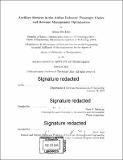| dc.contributor.advisor | Peter P. Belobaba. | en_US |
| dc.contributor.author | Bockelie, Adam. | en_US |
| dc.contributor.other | Massachusetts Institute of Technology. Department of Civil and Environmental Engineering. | en_US |
| dc.date.accessioned | 2019-07-22T19:33:12Z | |
| dc.date.available | 2019-07-22T19:33:12Z | |
| dc.date.copyright | 2019 | en_US |
| dc.date.issued | 2019 | en_US |
| dc.identifier.uri | https://hdl.handle.net/1721.1/121879 | |
| dc.description | Thesis: Ph. D. in Transportation, Massachusetts Institute of Technology, Department of Civil and Environmental Engineering, 2019 | en_US |
| dc.description | Cataloged from PDF version of thesis. | en_US |
| dc.description | Includes bibliographical references (pages 274-282). | en_US |
| dc.description.abstract | The recent proliferation of ancillary services means that airline passengers can face substantially different ancillary service prices and offerings based on their itinerary and fare class selection. At the same time, airlines have become interested in accounting for this supplementary revenue stream in their revenue management (RM) systems to maximize total, not just ticket, revenue. This thesis develops models for both of these issues, with a goal of providing a better understanding of how ancillary services affect the airline industry. We develop the Ancillary Choice Model (ACM) to describe how passengers make purchase decisions about ancillary services in conjunction with the selection of a fare class. We model two extremes of passenger knowledge and awareness of ancillary services, which we term simultaneous and sequential. We show that under the simultaneous model, the presence and price of ancillary services can affect the fare class selection of a passenger, even when all fare classes have the same ancillary prices. The second part of this thesis studies total revenue optimization. We provide a detailed assessment of a prior total revenue maximization approach, the Optimizer Increment (01), proving that it can be an optimal revenue management strategy under limited conditions, but also showing through the Passenger Origin-Destination Simulator (PODS) that it decreases revenue in more realistic environments. We then develop a new revenue management optimization model, the Ancillary Choice Dynamic Program (ACDP), which maximizes total revenue by explicitly including the revenue and fare class choice impacts of ancillary services. We describe an Ancillary Marginal Demand (AMD) and Ancillary Marginal Revenue (AMR) transformation that can be used as heuristics to provide the ancillary and choice awareness benefits of ACDP to existing RM optimization models. | en_US |
| dc.description.statementofresponsibility | by Adam Bockelie. | en_US |
| dc.format.extent | 282 pages | en_US |
| dc.language.iso | eng | en_US |
| dc.publisher | Massachusetts Institute of Technology | en_US |
| dc.rights | MIT theses are protected by copyright. They may be viewed, downloaded, or printed from this source but further reproduction or distribution in any format is prohibited without written permission. | en_US |
| dc.rights.uri | http://dspace.mit.edu/handle/1721.1/7582 | en_US |
| dc.subject | Civil and Environmental Engineering. | en_US |
| dc.title | Ancillary services in the airline industry : passenger choice and revenue management optimization | en_US |
| dc.type | Thesis | en_US |
| dc.description.degree | Ph. D. in Transportation | en_US |
| dc.contributor.department | Massachusetts Institute of Technology. Department of Civil and Environmental Engineering | en_US |
| dc.identifier.oclc | 1102637681 | en_US |
| dc.description.collection | Ph.D.inTransportation Massachusetts Institute of Technology, Department of Civil and Environmental Engineering | en_US |
| dspace.imported | 2019-07-22T19:33:09Z | en_US |
| mit.thesis.degree | Doctoral | en_US |
| mit.thesis.department | CivEng | en_US |
